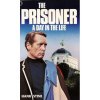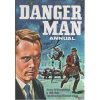Transition to The Prisoner
McGoohan resigned from the series, forcing its cancellation. He created a new project titled
The Prisoner, with
David Tomblin as co-producer and
George Markstein as script editor. Markstein was then the
Danger Man script consultant. A number of behind-the-scenes personnel on
Danger Man were subsequently hired for
The Prisoner.
[8] An unused, fourth-series script was reworked as an episode of
The Champions.
Secret agent John Drake and Prisoner Number Six
Prisoner fans frequently debate whether John Drake of
Danger Man and Number Six in
The Prisoner are the same person.
[11] Like John Drake, Number Six is evidently a secret agent, but one who has resigned from his job.
According to
The Prisoner: The Official Companion by Robert Fairclough, the
Prisoner episode "
The Girl Who Was Death" was based upon a two-part
Danger Man script that had been planned for the fourth series. In this
surreal episode, Number Six meets "Potter", John Drake's
Danger Man contact.
Christopher Benjamin portrayed the character in both series. As well as guest-starring in this show,
Paul Eddington played another spy and No.6's former colleague, Cobb, in the opening episode of the latter show.
The first
Danger Man season includes four episodes which use footage filmed in the Welsh resort of
Portmeirion, which later became the primary shooting location of the
Village in
The Prisoner. Further inspiration came from a Danger Man episode called "Colony Three", in which Drake infiltrates a spy school in Eastern Europe during the Cold War. The school, in the middle of nowhere, is set up to look like a normal English town in which pupils and instructors mix as in any other normal city, but the instructors are virtual prisoners with little hope of ever leaving. It is often thought this episode was a precursor to
The Prisoner; it was filmed in the new town of
Hatfield, Hertfordshire.
[12]
Even reference books conflict on
The Prisoner as a
Danger Man continuation. Vincent Terrace's
The Complete Encyclopedia of Television Programs 1947–1979 postulates that John Drake's resignation reason is revealed in the "
Do Not Forsake Me Oh My Darling" episode, which is a follow-up to a mission assigned to Number Six before he was sent to The Village. Richard Meyers makes the same claim in his 1981 book,
TV Detectives. He further states that this connects directly to "an episode of
Secret Agent never shown in this country [i.e. the United States] with John Drake investigating the story of a brain transferral device in Europe",
[13] but no such episode of
Danger Man was ever made. McGoohan stated in a 1985 interview that the two characters were not the same, and that he had originally wanted a different actor to play the role of Number Six.
Pop culture references
Danger Man has remained part of
pop culture consciousness. Author
Stephen King alludes to John Drake's cool in his novel
The Shining. The band
Tears for Fears refer to the character in their song "Swords and Knives", and
Dead Can Dance titled one of the songs on their
Into the Labyrinth album "The Ubiquitous Mr. Lovegrove" after a
Danger Manepisode, although the content of the song has no apparent relationship to the episode.
The American theme song has appeared in countless movies and TV shows, including during the climax of the first
Austin Powers movie, and was covered by
Devo.
In 2000, the
UPN network aired a short-lived spy series entitled
Secret Agent Man. Due to the similarities in titles between this series and the American edition of
Danger Man,
Secret Agent Man, a series with no relationship to the McGoohan program, is often erroneously referred to as a
spin-off or remake of
Danger Man.
The British animated series
Danger Mouse was largely inspired by
Danger Man and is a broad parody of both this series and secret agent films and television in general.






